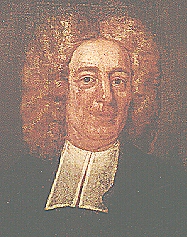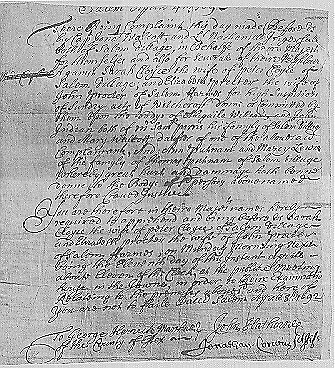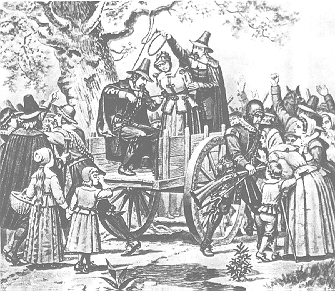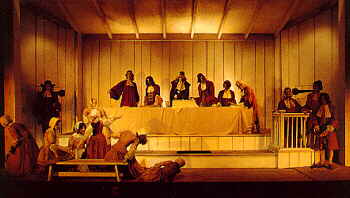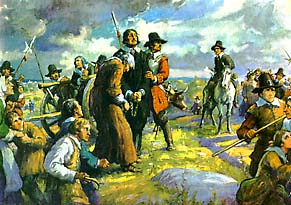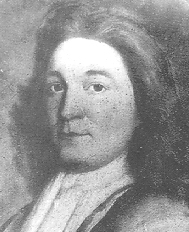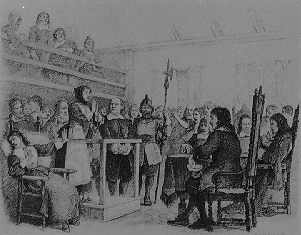
The world, redeemed from superstition's sway,
Is breathing freer for thy sake today.
From June through September of 1692, nineteen men and women, all having been convicted of witchcraft, were carted to Gallows Hill, a barren slope near Salem Village, for hanging. Another man of over eighty years was pressed to death under heavy stones for refusing to submit to a trial on witchcraft charges. Hundreds of others faced accusations of witchcraft. Dozens languished in jail for months without trials. Then, almost as soon as it had begun, the hysteria that swept through Puritan Massachusetts ended.
Why did this travesty of justice occur? Why did it occur in Salem? Nothing about this tragedy was inevitable. Only an unfortunate combination of an ongoing frontier war, economic conditions, congregational strife, teenage boredom, and personal jealousies can account for the spiraling accusations, trials, and executions that occurred in the spring and summer of 1692.

Rev. Samuel Parris
In 1688, John Putnam, one of the most influential elders of Salem Village, invited Samuel Parris, formerly a marginally successful planter and merchant in Barbados, to preach in the Village church. A year later, after negotiations over salary, inflation adjustments, and free firewood, Parris accepted the job as Village minister. He moved to Salem Village with his wife Elizabeth, his six-year-old daughter Betty, niece Abigail Williams, and his Indian slave Tituba, acquired by Parris in Barbados.
The Salem that became the new home of Parris was in the midst of change: a mercantile elite was beginning to develop, prominent people were becoming less willing to assume positions as town leaders, two clans (the Putnams and the Porters) were competing for control of the village and its pulpit, and a debate was raging over how independent Salem Village, tied more to the interior agricultural regions, should be from Salem, a center of sea trade.
Sometime during February of the exceptionally cold winter of 1692, young Betty Parris became strangely ill. She dashed about, dove under furniture, contorted in pain, barked like a dog, fell dumb, babbled nonsensically, and complained of fever. In one moment that must have shocked her father, she threw a Bible across a room. The cause of her symptoms may have been some combination of stress, asthma, guilt, boredom, child abuse, epilepsy, and delusional psychosis. (The symptoms also could have been caused, as Linda Caporael argued in a 1976 article in Science magazine, by a disease called "convulsive ergotism" brought on by ingesting rye--eaten as a cereal and as a common ingredient of bread--infected with ergot. (Ergot is caused by a fungus which invades developing kernels of rye grain, especially under warm and damp conditions such as existed at the time of the previous rye harvest in Salem. Convulsive ergotism causes violent fits, a crawling sensation on the skin, vomiting, choking, and--most interestingly--hallucinations. The hallucinogenic drug LSD is a derivative of ergot.) Many of the symptoms or convulsive ergotism seem to match those attributed to Betty Parris, but there is no way of knowing with any certainty if she in fact suffered from the disease--and the theory would not explain the afflictions suffered by others in Salem later in the year.)
Other girls Betty knew began to exhibit similar symptoms. Abigail Williams tried to launch herself into the air. Eleven-year-old Ann Putnam and two seventeen-year-olds, Mercy Lewis and Mary Walcott, began to exhibit highly unusual behavior as well. Four, then five, then six girls acting so bizarrely. What could be happening? Was it possible the Devil was at work?
Cotton Mather
Cotton Mather had recently published a popular book, "Memorable Providences," describing the suspected witchcraft of an Irish washerwoman in Boston, and Betty's behavior in some ways mirrored that of the afflicted person described in Mather's widely read and discussed book. Mather concluded Memorable Providences with this thought: "I am resolved after this, never to use but just one grain of patience with any man that shall. . . impose upon me a denial of devils or of witches. I shall count him down-right impudent if he assert the non-existence of thing which we have had such palpable convictions of."
It was easy to believe in 1692 in Salem, with an Indian war raging less than seventy miles away (and many refugees from the war in the area) that the devil was close at hand. Sudden and violent death occupied minds. In 1692, few doubted that Satan was real or that he acted in the world. The Devil sowed disease and bad fortune; he orchestrated natural catastrophes.
When his own nostrums failed to effect a cure, William Griggs, a doctor called to examine the girls, suggested that the girls' problems might have a supernatural origin. The widespread belief that witches targeted children made the doctor's diagnosis seem increasingly likely.
A neighbor, Mary Sibley, proposed a form of counter magic to the Parris family Indian slave, John. Sibley told John to bake a rye cake containing Betty's and Abigail's urine and to feed the cake to the family dog. ( Why a dog? Dogs were believed to be used by witches as agents to carry out their devilish commands. The cake could draw the witch to the animal, perhaps even transfer the witch's spell to it. Nice try, but it didn't work.) The witch cake experiment infuriated Reverend Parris. The minister publicly reproached Sibley for bringing counter-magic into his parsonage. He called it "going to the Devil for help against the Devil.")
By late February, twelve-year-old Ann Putnam and Elizabeth Hubbard, a sixteen-year-old neice of Dr. Griggs, were also choking, shuddering, and showing other signs of witchcraft affliction. Thomas Putnam begged his daughter to identify who might be responsible for her odd behavior. She supplied three names.
On a rainy February 29, Thomas Putnam and three friends rode from Salem Village to Salem Town to press formal charges of witchcraft against three women. Acting on the charges, the constable arrested Sarah Good, Sarah Osborne, and Tituba, a slave working in Reverend Parris's parsonage. Tituba was an obvious choice, likely named because of her practice of sharing with the girls tales of omens, voodoo, and witchcraft from her native folklore (LINK TO TITUBA'S EXAMINATION). Good was a beggar and social misfit who lived wherever someone would house her (LINK TO GOOD'S EXAMINATION) (LINK TO GOOD'S TRIAL), and Osborne was old, quarrelsome, and had not attended church for over a year.
The Putnams brought their complaint against the three women to county magistrates Jonathan Corwin and John Hathorne, who ordered the suspected witches to appear the next morning, March 1, 1692, in Ingersoll's tavern. When hundreds showed up, the examinations were moved to the meeting house. The pews of the meeting house were crowded with curious farmers. The two justices of the peace sat at a table in front of the pulpit. After an opening prayer, Justice John Hawthorne wasted no time in getting down to business. "Sarah Good," he asked, "what evil spirit do you have familiarity with?"
At the examinations, the girls described attacks by the specters of the three women, and fell into their, by then, perfected pattern of contortions when in the presence of one of the suspects. The consistency of the two girls' accusations suggests strongly that the girls worked out their stories together. Ann Putnam and Mercy Lewis were also reporting seeing "witches flying through the winter mist." With the prominent Putnam family supporting the girls' accusations, their accusations would be taken seriously.Other villagers came forward to offer stories of cheese and butter mysteriously gone bad or animals born with deformities after visits by one of the suspects.The magistrates, in the common practice of the time, asked the same questions of each suspect over and over: Were they witches? Had they seen Satan? How, if they are were not witches, did they explain the contortions seemingly caused by their presence? The style and form of the questions indicates that the magistrates thought the women guilty.
Meanwhile, the number of girls afflicted continued to grow, rising to seven with the addition of Susannah Sheldon as an accuser. According to historian Peter Hoffer, the girls "turned themselves from a circle of friends into a gang of juvenile delinquents." (Many people of the period complained that young people lacked the piety and sense of purpose of the founders' generation.) The girls contorted into grotesque poses, fell down into frozen postures, and complained of biting and pinching sensations. In a village where everyone believed that the devil was real, close at hand, and acted in the real world, the suspected affliction of the girls became an obsession.
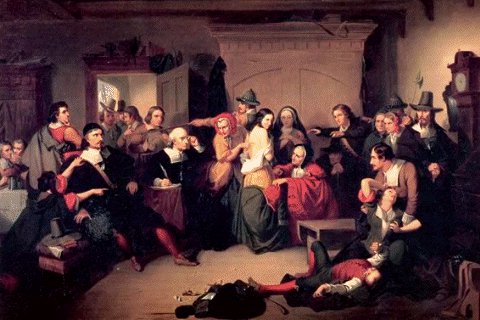
"Examination of a Witch"
The matter might have ended with admonishments were it not for Tituba. After first adamantly denying any guilt, afraid perhaps of being made a scapegoat, Tituba claimed that she was approached by a tall man from Boston--obviously Satan--who sometimes appeared as a dog or a hog and who asked her to sign in his book and to do his work. Yes, Tituba declared, she was a witch, and moreover she and four other witches, including Good and Osborne, had flown through the air on their poles. She had tried to run to Reverend Parris for counsel, she said, but the devil had blocked her path. The transcript includes this exchange:
Q: Where did you go?
T: Up to Putnams & make me hurt the Child.
Q: Who made you go?
T: Man that is very strong & these two women, Good and Osborne, but I am sorry.
Q: How did you go? What do you ride upon?
T: I ride upon a stick or pole & Good & Osborne behind me. We ride taking hold of one another. Don't know how we go for I saw no trees or path, but was presently there.
Tituba's confession succeeded in transforming her from a possible scapegoat to a central figure in the expanding prosecutions. Her confession also served to silence most skeptics, and Parris and other local ministers began witch hunting with zeal.
Soon, according to their own reports, the spectral forms of other women began attacking the afflicted girls. Martha Corey, Rebecca Nurse, Sarah Cloyce, and Mary Easty (LINK TO EASTY'S EXAMINATION) (LINK TO EASTY'S PETITION FOR MERCY) were accused of witchcraft. During a March 20 church service, Ann Putnam suddenly shouted, "Look where Goodwife Cloyce sits on the beam suckling her yellow bird between her fingers!" Soon Ann's mother, Ann Putnam, Sr., joined the chorus of accusers. Dorcas Good, four-year-old daughter of Sarah Good, became the first child to be accused of witchcraft when three of the girls complained that they were bitten by the specter of Dorcas. (The four-year-old was arrested, kept in jail for eight months, watched her mother get carried off to the gallows, and would "cry her heart out, and go insane.") The girls' accusations and their ever more polished performances, including the new act of being struck dumb, played to large and believing audiences.
Arrest warrant for suspected witchcraft
Stuck in jail with the damning testimony of the afflicted girls widely accepted, suspects began to see confession as a way to avoid the gallows. Deliverance Hobbs became the second witch to confess, admitting to pinching three of the girls at the Devil's command and flying on a pole to attend a witches' Sabbath in an open field.
Jails approached capacity and the colony "teetered on the brink of chaos" when Governor Phips returned from England. Fast action, he decided, was required. Phips created a new court, the "court of oyer and terminer," to hear the witchcraft cases. Five judges, including three close friends of Cotton Mather, were appointed to the court. Chief Justice, and most influential member of the court, was a gung-ho witch hunter named William Stoughton.
Chief Judge William Stoughton
Mather urged Stoughton and the other judges to credit confessions and admit "spectral evidence" (testimony by afflicted persons that they had been visited by a suspect's specter). Ministers were looked to for guidance by the judges, who were generally without legal training, on matters pertaining to witchcraft. Mather's advice was heeded. the judges also decided to allow the so-called "touching test" (defendants were asked to touch afflicted persons to see if their touch, as was generally assumed of the touch of witches, would stop their contortions) and examination of the bodies of accused for evidence of "witches' marks" (moles or the like upon which a witch's familiar might suck) (SCENE DEPICTING EXAMINATION FOR MARKS ). Evidence that would be excluded from modern courtrooms-- hearsay, gossip, stories, unsupported assertions, surmises-- was also generally admitted. Many protections that modern defendants take for granted were lacking in Salem: accused witches had no legal counsel, could not have witnesses testify under oath on their behalf, and had no formal avenues of appeal. Defendants could, however, speak for themselves, produce evidence, and cross-examine their accusers. The degree to which defendants in Salem were able to take advantage of their modest protections varied considerably, depending on their own acuteness and their influence in the community.
The court of oyer and terminer convened on June 2, 1692, in Salem Town. Technically, Salem Village was part of Salem Town, on the northern outskirts. But the two locales were very different in many respects.
The first accused witch to be brought to trial was Bridget Bishop. Almost sixty years old, owner of a tavern where patrons could drink cider ale and play shuffleboard (even on the Sabbath), critical of her neighbors, and reluctant to pay her bills, Bishop was a likely candidate for an accusation of witchcraft (LINK TO EXAMINATION OF BISHOP). The fact that Thomas Newton, special prosecutor, selected Bishop for his first prosecution suggests that he believed the stronger case could be made against her than any of the other suspect witches. At Bishop's trial on June 2, 1692, a field hand testified that he saw Bishop's image stealing eggs and then saw her transform herself into a cat. Deliverance Hobbs, by then probably insane, and Mary Warren, both confessed witches, testified that Bishop was one of them. A villager named Samuel Grey told the court that Bishop visited his bed at night and tormented him. A jury of matrons assigned to examine Bishop's body reported that they found an "excrescence of flesh." Several of the afflicted girls testified that Bishop's specter afflicted them. Numerous other villagers described why they thought Bishop was responsible for various bits of bad luck that had befallen them. There was even testimony that while being transported under guard past the Salem meeting house, she looked at the building and caused a part of it to fall to the ground. Bishop's jury returned a verdict of guilty. One of the judges, Nathaniel Saltonstall, aghast at the conduct of the trial, resigned from the court. Chief Justice Stoughton signed Bishop's death warrant, and on June 10, 1692, Bishop was carted to Gallows Hill and hanged, the first victim of the Salem trials.
The hanging of Bridget Bishop
As the summer of 1692 warmed, the pace of trials picked up. Not all defendants were as disreputable as Bridget Bishop. Rebecca Nurse was a pious, respected woman whose specter, according to Ann Putnam, Jr. and Abigail Williams, attacked them in mid March of 1692 (LINK TO EXAMINATION OF NURSE). Ann Putnam, Sr. added her complaint that Nurse demanded that she sign the Devil's book, then pinched her. Nurse was one of three Towne sisters, all identified as witches, who were members of a Topsfield family that had a long-standing quarrel with the Putnam family. Apart from the evidence of Putnam family members, the major piece of evidence against Nurse appeared to be testimony indicating that soon after Nurse lectured Benjamin Houlton for allowing his pig to root in her garden, Houlton died. The Nurse jury returned a verdict of not guilty, much to the displeasure of Chief Justice Stoughton, who told the jury to go back and consider again a statement of Nurse's that might be considered an admission of guilt (but more likely an indication of confusion about the question, as Nurse was old and nearly deaf). The jury reconvened, this time coming back with a verdict of guilty (LINK TO NURSE TRIAL). On July 19, 1692, Nurse rode with four other convicted witches to Gallows Hill.
Why was Nurse, a respected church-going woman, convicte? Nurse's quarrel with the Putnams and the testimony regarding her spat with Houton over his pig's rooting in her garden indicates how, as the summer progressed, the trials became not just a way of ridding the Village of old eccentrics; they also became a way to settle old scores.
The trial of Rebecca Nurse
Persons who scoffed at accusations of witchcraft risked becoming targets of accusations themselves. One man who was openly critical of the trials paid for his skepticism with his life. John Proctor, a central figure in Arthur Miller's fictionalized account of the Salem witch hunt, The Crucible, was an opinionated tavern owner who openly denounced the witch hunt. Testifying against Proctor were Ann Putnam, Abigail Williams, Indian John (a slave of Samuel Parris who worked in a competing tavern), and eighteen-year-old Elizabeth Booth, who testified that ghosts had come to her and accused Proctor of serial murder. Proctor fought back as best he could, accusing confessed witches of lying, complaining of torture, and demanding that his trial be moved to Boston. The efforts proved futile. Proctor was hanged. His wife Elizabeth, who was also convicted of witchcraft, was spared execution because of her pregnancy (reprieved "for the belly").
No execution caused more unease in Salem than that of the village's ex-minister, George Burroughs. Burroughs, who was living in Maine in 1692, was identified by several of his accusers as the ringleader of the witches. Ann Putnam claimed that Burroughs bewitched soldiers during a failed military campaign against Wabanakis in 1688-89, the first of a string of military disasters that could be blamed on an Indian-Devil alliance. In her interesting book, In the Devil's Snare, historian Mary Beth Norton argues that the large number of accusations against Burroughs, and his linkage to the frontier war, is the key to understanding the Salem trials. Norton contends that the enthusiasm of the Salem court in prosecuting the witchcraft cases owed in no small measure to the judges' desire to shift the "blame for their own inadequate defense of the frontier." Many of the judges, Norton points out, played lead roles in a war effort that had been markedly unsuccessful.
Among the thirty accusers of Burroughs was nineteen-year-old Mercy Lewis, a refugee of the frontier wars. Lewis, the most imaginative and forceful of the young accusers, offered unusually vivid testimony against Burroughs. Lewis told the court that Burroughs flew her to the top of a mountain and, pointing toward the surrounding land, promised her all the kingdoms if only she would sign in his book (a story very similar to that found in Matthew 4:8). Lewis said, "I would not writ if he had throwed me down on one hundred pitchforks." At an execution, a defendant in the Puritan colonies was expected to confess, and thus to save his soul. When Burroughs on Gallows Hill continued to insist on his innocence and then recited the Lord's Prayer perfectly (something witches were thought incapable of doing), the crowd reportedly was "greatly moved." The agitation of the crowd caused Cotton Mather to intervene and remind the crowd that Burroughs had had his day in court and lost.
The hanging of George Burroughs
One victim of the Salem witch hunt was not hanged, but rather pressed under heavy stones until his death. Such was the fate of octogenarian Giles Corey who, after spending five months in chains in a Salem jail with his also accused wife, had nothing but contempt for the proceedings. Seeing the futility of a trial and hoping that by avoiding a conviction his farm, that would otherwise go the state, might go to his two sons-in-law, Corey refused to stand for trial. The penalty for such a refusal was peine et fort, or pressing. Three days after Corey's death, on September 22, 1692, eight more convicted witches, including Giles' wife Martha, were hanged. They were the last victims of the witch hunt.
Some of the most moving words about the Salme hysteria can be found in the petitions written by the condemned witches. Mary Easty, in her petition to Governor Phips and the judges of the court, blamed her convictions on the "wiles and subtleties" of her accusers. Then she wrote: "I am now condemned to die. The Lord knows my innocence. . .I petition your honors not for my own life, for I know I must die and my appointed time is set, but that no more innocent blood be shed, which undoubtedly cannot be avoided in the way and course you go."
By early autumn of 1692, Salem's lust for blood was ebbing. Doubts were developing as to how so many respectable people could be guilty. Reverend John Hale said, " It cannot be imagined that in a place of so much knowledge, so many in so small compass of land should abominably leap into the Devil's lap at once." The educated elite of the colony began efforts to end the witch-hunting hysteria that had enveloped Salem. Increase Mather, the father of Cotton, published what has been called "America's first tract on evidence," a work entitled Cases of Conscience, which argued that it "were better that ten suspected witches should escape than one innocent person should be condemned." Increase Mather urged the court to exclude spectral evidence. Samuel Willard, a highly regarded Boston minister, circulated Some Miscellany Observations on Our Present Debates Respecting Witchcraft, which suggested that the Devil might create the specter of an innocent person. Mather's and Willard's works were given to Governor Phips.
The writings most likely influenced the decision of Phips to order the court to exclude spectral evidence and touching tests and to require proof of guilt by clear and convincing evidence. With spectral evidence not admitted, twenty-eight of the last thirty-three witchcraft trials ended in acquittals. The three convicted witches were later pardoned. In May of 1693, Phips released from prison all remaining accused or convicted witches. Salem's nightmare was over.
Governor William Phips
By the time the witch hunt ended, nineteen convicted witches were executed (LINK TO LIST OF DEAD), at least four accused witches had died in prison, and one man, Giles Corey, had been pressed to death. About one to two hundred other persons were arrested and imprisoned on witchcraft charges. Two dogs were executed as suspected accomplices of witches. As a side note, Tituba recanted her confession--an act that enraged Reverend Parris. In retaliation, Parris refused to pay the jailer's fee to get his slave out of prison. Tituba spent some thirteen months in jail until an unknown person paid seven pounds for her release.
Scholars have noted potentially telling differences between the accused and the accusers in Salem. Most of the accused lived to the south of, and were generally better off financially, than most of the accusers. In a number of cases, accusing families stood to gain property from the convictions of accused witches. Also, the accused and the accusers generally took opposite sides in a congregational schism that had split the Salem community before the outbreak of hysteria. While many of the accused witches supported former minister George Burroughs, the families that included the accusers had--for the most part--played leading roles in forcing Burroughs to leave Salem. The conclusion that many scholars draw from these patterns is that property disputes and congregational feuds played a major role in determining who lived, and who died, in 1692.

The repentence of Samuel Sewall
A period of atonement began in the colony following the release of the surviving accused witches. Samuel Sewall, one of the judges, issued a public confession of guilt and an apology. Several jurors came forward to say that they were "sadly deluded and mistaken" in their judgments. Reverend Samuel Parris conceded errors of judgment, but mostly shifted blame to others. Parris was replaced as minister of Salem village by Thomas Green, who devoted his career to putting his torn congregation back together. Governor Phips blamed the entire affair on William Stoughton. Stoughton, clearly more to blame than anyone for the tragic episode, refused to apologize or explain himself. He criticized Phips for interfering just when he was about to "clear the land" of witches. Stoughton became the next governor of Massachusetts.
The witches disappeared, but witch hunting in America did not. Each generation must learn the lessons of history or risk repeating its mistakes. Salem should warn us to think hard about how to best safeguard and improve our system of justice.

